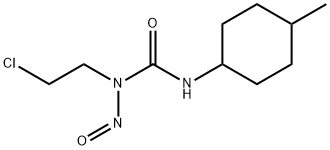1-(2-클로로에틸)-3-(4-메틸시클로헥실)-1-니트로소요소 C화학적 특성, 용도, 생산
개요
In October 2008, scientists of the International Agency for
Research on Cancer reaffirmed the Group 1 classification
‘carcinogenic to humans’ of 20 pharmaceutical agents
including semustine. Me-CCNU [1-(2-chloroethyl)-3-
(4-methylcyclohexyl)-1-nitrosourea] is an alkylating agent of
the nitrosourea group, used alone or in combination with other
chemotherapeutic agents to treat several types of cancers,
including primary and metastatic brain tumors, Lewis lung
tumor, and L1210 leukemia. It has also been used to treat
cancers of the digestive tract, Hodgkin lymphoma, malignant
melanoma, and epidermoid carcinoma of the lung. Doses varied
depending on the type of cancer and body weight of the individual.
The typical oral dose was 125–200 mgm-2 body surface
area, and was repeated every 6 weeks. An alternative regimen
was reported to be 200–225 mg m-2 orally every 6–8 weeks.
Me-CCNU is a bifunctional antineoplastic agent that undergoes
spontaneous chemical decomposition, yielding electrophilic
compounds and ultimately inducing alkylation and carbamoylation
of cellular macromolecules, including DNA and protein.
화학적 성질
A crystalline solid or light yellow powder.
용도
Commonly used in pharmacological studies involving: • ;Nutrient-sensitized screening for drugs that shift the energy metabolism from mitchondrial respiration to glycolysis1• ;CEOP regimen with semustine used as induction chemotherapy in patients with lymphoma2• ;Investigations into its use for chemotherapy3,4
정의
ChEBI: An organochlorine compound that is urea in which the two hydrogens on one of the amino groups are replaced by nitroso and 2-chloroethyl groups and one hydrogen from the other amino group is replaced by a 4-methylcyclohexyl group.
일반 설명
Light yellow powder.
공기와 물의 반응
Insoluble in water.
반응 프로필
A halogenated and nitrated amide. Organic amides/imides react with azo and diazo compounds to generate toxic gases. Flammable gases are formed by the reaction of organic amides/imides with strong reducing agents. Amides are very weak bases (weaker than water). Imides are less basic yet and in fact react with strong bases to form salts. That is, they can react as acids. Mixing amides with dehydrating agents such as P2O5 or SOCl2 generates the corresponding nitrile. The combustion of these compounds generates mixed oxides of nitrogen (NOx).
화재위험
Flash point data for SEMUSTINE are not available. SEMUSTINE is probably combustible.
Safety Profile
Confirmed human
carcinogen producing leukemia.
Experimental carcinogenic and tumorigenic
data. Poison by ingestion, intraperitoneal,
intravenous, and possibly other routes.
Mutation data reported. Human systemic
effects by ingestion: nausea or vomiting,
damage to kidney tubules and glomeruli, and
hematuria (blood in the urine). When heated
to decomposition it emits very toxic fumes
of Cland NOx. See also N-NITROSO
COMPOUNDS.
잠재적 노출
Semustine is chemotherapy agent; an antineoplastic agent which functions as an alkylating agent.
Carcinogenicity
1-(2-Chloroethyl)-3-(4-methylcyclohexyl)-1-nitrosourea (methyl-CCNU) is known to be a human carcinogen based on sufficient evidence of carcinogenicity from studies in humans.
운송 방법
UN3249 Medicine, solid, toxic, n.o.s., Hazard Class: 6.1; Labels: 6.1-Poisonous materials. PG II.
비 호환성
Incompatible with oxidizers (chlorates, nitrates, peroxides, permanganates, perchlorates, chlorine, bromine, fluorine, etc.); contact may cause fires or explosions. Keep away from strong acids, alkaline materials, strong bases. Semustine, an organic amide, reacts with azo and diazo compounds, releasing toxic gases. Amides are very weak bases but they can react as acids, forming salts. Contact with reducing agents can release flammable gases. Mixing amides with dehydrating agents such as such as phosphorus pentoxide or thionyl chloride generates the corresponding nitrile.
폐기물 처리
It is inappropriate to dispose of expired or waste drugs and pharmaceuticals by flushing them down the toilet or discarding them to the trash. Household quantities of expired or waste pharmaceuticals may be mixed with wet cat litter or coffee grounds, doublebagged in plastic, discard in trash. Larger quantities shall carefully take into consideration applicable DEA, EPA, and FDA regulations. If possible return the pharmaceutical to the manufacturer for proper disposal being careful to properly label and securely package the material. Alternatively, the waste pharmaceutical shall be labeled, securely packaged and transported by a state licensed medical waste contractor to dispose by burial in a licensed hazardous or toxic waste landfill or incinerator.
1-(2-클로로에틸)-3-(4-메틸시클로헥실)-1-니트로소요소 준비 용품 및 원자재
원자재
준비 용품








